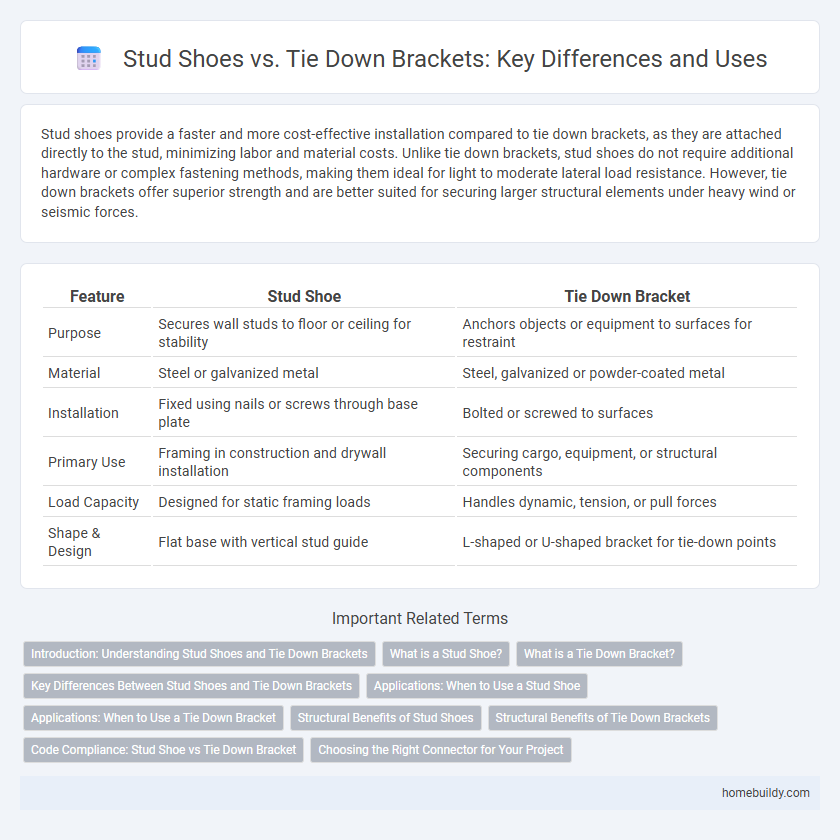Stud shoes provide a faster and more cost-effective installation compared to tie down brackets, as they are attached directly to the stud, minimizing labor and material costs. Unlike tie down brackets, stud shoes do not require additional hardware or complex fastening methods, making them ideal for light to moderate lateral load resistance. However, tie down brackets offer superior strength and are better suited for securing larger structural elements under heavy wind or seismic forces.
Table of Comparison
| Feature | Stud Shoe | Tie Down Bracket |
|---|---|---|
| Purpose | Secures wall studs to floor or ceiling for stability | Anchors objects or equipment to surfaces for restraint |
| Material | Steel or galvanized metal | Steel, galvanized or powder-coated metal |
| Installation | Fixed using nails or screws through base plate | Bolted or screwed to surfaces |
| Primary Use | Framing in construction and drywall installation | Securing cargo, equipment, or structural components |
| Load Capacity | Designed for static framing loads | Handles dynamic, tension, or pull forces |
| Shape & Design | Flat base with vertical stud guide | L-shaped or U-shaped bracket for tie-down points |
Introduction: Understanding Stud Shoes and Tie Down Brackets
Stud shoes are specialized connectors used in construction to secure wall studs to the floor or ceiling, providing stability and load transfer. Tie down brackets function as metal fasteners designed to resist uplift and lateral forces by anchoring structural components to their foundations or other framing elements. Understanding the differences in design, application, and load resistance between stud shoes and tie down brackets is critical for ensuring optimal structural performance and code compliance.
What is a Stud Shoe?
A Stud Shoe is a specialized component designed to securely anchor structural elements by fastening directly to a stud in wall framing. Unlike tie down brackets, which often attach to multiple framing members for load distribution, stud shoes offer precise point support that enhances stability and prevents lateral movement. Engineered for efficient load transfer, stud shoes are essential in reinforcing wall assemblies in residential and commercial construction.
What is a Tie Down Bracket?
A tie down bracket is a metal fastening device used to secure cargo, equipment, or structures by providing anchor points for straps or chains. Unlike stud shoes, which primarily support vertical loads in construction, tie down brackets are designed to resist lateral and uplift forces, enhancing stability and safety during transportation or installation. These brackets are essential in applications requiring strong, reliable connections to prevent shifting or movement under stress.
Key Differences Between Stud Shoes and Tie Down Brackets
Stud shoes provide a secure fastening solution by anchoring bolts or studs in concrete, ensuring structural stability in construction projects. Tie down brackets offer versatile metal connectors used to reinforce wood framing by securing beams or posts to concrete or other substrates. The key difference lies in their application: stud shoes primarily support vertical loads for embedded anchors, while tie down brackets focus on lateral load resistance and framing connections.
Applications: When to Use a Stud Shoe
Stud shoes are ideal for anchoring structural elements in concrete foundations where secure load transfer is critical, such as in heavy machinery installations and steel column connections. They offer superior shear and tensile strength compared to tie down brackets, making them suitable for high-stress applications in industrial and commercial construction. Use stud shoes when precise alignment and maximum load-bearing capacity are required to ensure structural integrity.
Applications: When to Use a Tie Down Bracket
Tie down brackets are essential in scenarios requiring adjustable anchoring points and enhanced load distribution, making them ideal for securing heavy or awkwardly shaped cargo. Unlike stud shoes, which offer fixed attachment, tie down brackets provide flexibility in positioning straps or chains for safety harnesses or equipment stabilization. Use tie down brackets in applications involving dynamic loads, such as transport trucks, trailers, and construction sites where vibration or movement occurs frequently.
Structural Benefits of Stud Shoes
Stud shoes provide superior structural stability by securely anchoring rebar within concrete, ensuring effective load transfer and minimizing the risk of slippage compared to tie down brackets. Their design distributes stress evenly across the connection points, enhancing the overall durability and performance of the structure under dynamic loads. The welded attachment of stud shoes facilitates faster installation and reduces the likelihood of corrosion, making them a more reliable choice for long-term structural integrity.
Structural Benefits of Tie Down Brackets
Tie down brackets offer superior structural reinforcement by securely anchoring studs to the foundation, reducing lateral movement and enhancing overall building stability. They distribute loads more evenly compared to traditional stud shoes, minimizing stress concentrations and potential failure points. This improved connection increases resistance to seismic and wind forces, promoting long-term durability in construction frameworks.
Code Compliance: Stud Shoe vs Tie Down Bracket
Stud shoes provide superior code compliance compared to tie down brackets by meeting strict load requirements outlined in the International Building Code (IBC) and American Wood Council standards. Unlike tie down brackets, stud shoes are designed to deliver continuous load paths and precise fastening to wood framing, ensuring enhanced structural integrity during seismic or wind events. Their engineered performance and rigorous testing allow builders to achieve higher safety margins and pass inspections more reliably under local and national building codes.
Choosing the Right Connector for Your Project
Stud shoes provide a secure anchor point for attaching wooden studs to concrete or steel surfaces, offering strong load-bearing capacity ideal for framing projects. Tie down brackets, designed to resist uplift and lateral forces, enhance structural stability by connecting framing members to foundations or other framing components. Selecting between stud shoes and tie down brackets depends on the specific load requirements, environmental conditions, and building codes relevant to your construction project.
Stud shoe vs tie down bracket Infographic

 homebuildy.com
homebuildy.com